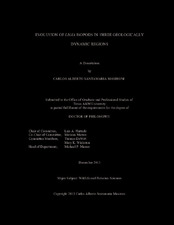| dc.description.abstract | The oniscidean genus Ligia has a cosmopolitan distribution, occurring mainly in rocky supralittoral habitats, although a few species are found in tropical mountain freshwater habitats. The long-distance dispersal potential of the coastal Ligia isopods is very limited, due to a series of biological characteristics, which contributes to a high isolation of their populations. Consistent with this, high levels of allopatric differentiation have been detected for coastal Ligia in different parts of the world, with phylogeographic patterns exhibiting signatures of past geological and oceanographic events. In this dissertation, we used mitochondrial and nuclear gene sequences to infer phylogeographic patterns of Ligia isopods in the Hawaiian archipelago, and the region comprised by the Caribbean Sea and the Eastern Pacific coast of Colombia and Central America. We also conducted geometric-morphometric analyses to determine whether differences in overall body shape exist between divergent lineages in coastal Ligia from the Hawaiian archipelago and from the region between Central California and Central Mexico, including the Gulf of California. We observed that Ligia populations from the Caribbean Sea and the Pacific coast of Central America and Colombia, as well as those from the Hawaiian archipelago, harbor highly divergent lineages, suggesting that the Ligia species recognized for these regions represent cryptic species complexes. Phylogeographic patterns suggest that passive overwater dispersal has been an important factor shaping the evolutionary history of Ligia in these two regions. Geometric morphometric approaches uncovered morphological differences between highly divergent genetic lineages of Ligia isopods in the Hawaiian archipelago and the region between Central California and Central Mexico, including the Gulf of California. Large overlap in body shapes occur, however, suggesting overall body shape evolution is somewhat constrained and this character is unreliable for taxonomic distinction of these lineages. | en |


